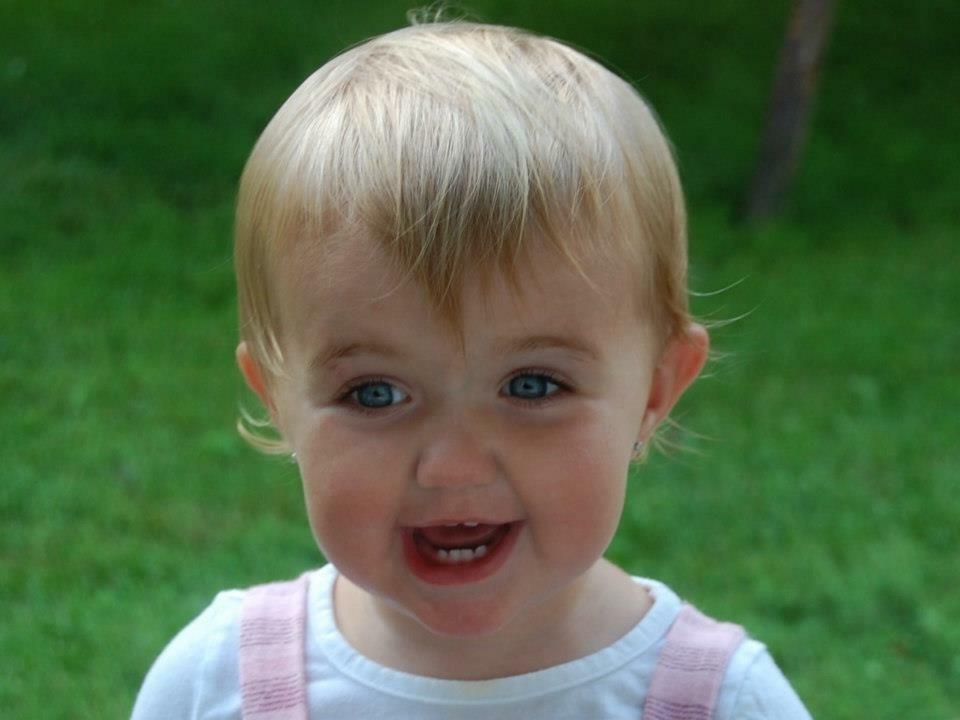
Edna Mae “Em” {courtesy family}
By Sallie James
Nine years after Casey McGovern’s youngest daughter drowned in a backyard pool, the mother of three is still haunted by what she didn’t know then and driven by what she wants parents to know today.
McGovern is the Florida Department of Health in Broward County’s Drowning Prevention Program Manager, and her mission is to save as many lives as possible through education. Her passion about water safety stems from the personal pain she experienced on August 3, 2009, when she found her 19-month-old daughter Edna Mae floating face-up in the pool the child had been playing in just hours earlier. “Em” died eight days later on August 11.
“You think you are going to hear it. People think they are going to hear flailing and splashing and yelling. It’s quicker than you think,” said McGovern, who has devoted her life to raising awareness about the dangers of water. “A drowning can occur in as little as 60 seconds.”

Casey McGovern and her daughter, “Em.”
McGovern, then the mother of three girls, ages 10, 3, and 19 months, had spent the day in their backyard pool in Coral Springs with her kids. After pool time ended, McGovern put Em down for a supervised nap and went grocery shopping.
Upon arriving home, she placed the toddler in a chair in the family room, on the other side of a counter that separated the room from the kitchen. McGovern, who had been unloading groceries, stepped away to chat with her husband in another room. She was only gone a minute.
When she returned, Em was gone. McGovern searched inside the house, then stepped outside to check the side yard. She tragically found the blue-eyed blond floating face-up in the pool.
It was too late.
Today, McGovern talks freely about the horrific tragedy because she wants other parents to know how quickly a drowning can happen, how easy it is for young children to bypass safety measures and that no one is exempt.
Her key points?
- Drowning is silent
- Drowning is preventable
- Drowning can happen to YOU
At the time of her daughter’s death, McGovern had a child safety fence encircling her pool, but no door chimes on the rear slider that led out to the pool deck, something she strongly encourages today – and is required by law on new homes and pools. The pool fence gate had not been latched that fateful day. McGovern said she also wasted precious minutes searching for her daughter inside the house.
Check the water first is what she tells parents today. If your child is in the house somewhere, they are safe.
“We thought we were doing everything right. We had child-proofed our home the way we were supposed to, we had the pool fence, plugs in the sockets, covers on all the chemicals under the sink,” McGovern recalled. “We never thought about the pool as a danger. We put up a pool fence to appease my mother. It did not have a self-closing, self-latching gate. I didn’t think about the door opening. I didn’t think about the door being a hazard. There are so many things I didn’t think about, wasn’t educated on.”
According to the Florida Department of Children and Families, 12 children ages four and younger drowned in 2017 and 2018 combined in Broward County. The deaths occurred in family pools, community pools, lakes, the ocean, and canals. Risks are elevated in Broward, with 125,000 backyard pools and miles of waterways.
“Because our county is covered in water and its swim season all year long, year after year our statistics show we are one of the highest counties in the state of Florida for drowning fatalities,” McGovern noted.
When McGovern speaks to parent groups, she compares a child playing in a pool unsupervised to allowing a child to play in busy traffic on Interstate I-95.
“It’s just as dangerous,” McGovern said. “Because a pool is so inviting people disregard how dangerous it can be.”

The McGovern’s children with a photo of “Em.”
Pool parties are risky too unless there is a designated water watcher who keeps their eye out for kids who may go under and not come up. “Floaties” give young swimmers a false sense of security, she added.
She recommends children start swim lessons as soon as they begin to crawl.
To get the word out about water safety, DOH-Broward has two drowning prevention educators who conduct outreach in the community by visiting schools, cities and working with high school students in Students Preventing Unintentional Drownings (SPUD) clubs across Broward County.
“We try to be part of any city that does water safety – at aquatic centers, pools, and parks. We talk to the parents about swim lessons, vehicle escape, and SPUD,” said Vanessa Figueroa, one of the DOH’s drowning prevention specialists. “With SPUD, we work with high school students to create water safety ambassadors.”
The educators stress supervision, barriers, acting fast, and swim lessons. They also emphasize that drowning can happen to anyone, from any walk of life.
“I think knowledge is power and I think the more people who relate and connect to my story may cause changes,” McGovern said.
To help with swim lessons, the Children’s Services Council of Broward County provides a $40 swim voucher to any Broward County resident age six months to four years old. The voucher is available to Broward County residents annually, up until their fifth birthday.
For more information on water safety, visit www.watersmartbroward.org.
Sallie James works in Community Affairs for the Florida Department of Health in Broward County, chairs the agency’s Outreach Planning Group and helps to communicate health-related information to the public. She is a former reporter for Sun Sentinel.
Author Profile

Related
 NewsDecember 1, 2025Broward County Commissioner Udine Highlights New Omni Hotel, Sand Bypass Project and Local Holiday Traditions
NewsDecember 1, 2025Broward County Commissioner Udine Highlights New Omni Hotel, Sand Bypass Project and Local Holiday Traditions NewsDecember 1, 2025Coral Springs Commission: Holiday Lights, Parades, and Family Fun Shine Across the City This December
NewsDecember 1, 2025Coral Springs Commission: Holiday Lights, Parades, and Family Fun Shine Across the City This December NewsOctober 1, 2025Coral Springs Commission: October Brings Oktoberfest, Fire Safety and Halloween Fun
NewsOctober 1, 2025Coral Springs Commission: October Brings Oktoberfest, Fire Safety and Halloween Fun NewsSeptember 1, 2025Broward Commissioner Udine: September Brings School, Culture, and Community Events Acros
NewsSeptember 1, 2025Broward Commissioner Udine: September Brings School, Culture, and Community Events Acros







